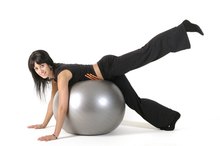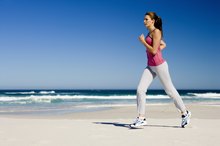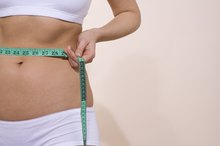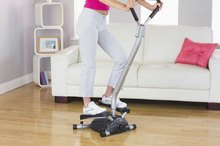How Does Exercise Clear Plaque Out of Arteries?
Cholesterol is a fatty substance that your body makes and uses for important functions. You also get cholesterol from the foods you eat. Too much cholesterol in your blood can cause the buildup of plaque in your arteries, a condition called hardening of the arteries or atherosclerosis. Plaque buildup can narrow your arteries and block the flow of blood. High cholesterol levels can cause heart disease and other serious medical conditions. Regular exercise can help remove plaque from your arteries by affecting the balance of the two types of cholesterol.
Two Kinds of Cholesterol
Lipoproteins carry cholesterol through your bloodstream. Low-density lipoprotein, or LDL, is known as bad cholesterol that builds up in your arteries and restricts blood flow. High levels of LDL cholesterol places you at greater risk for heart disease. Higher HDL, or good, cholesterol levels mean less risk of developing heart disease. According to the National Heart Lung and Blood Institute, LDL cholesterol levels of 160 to 189 mg/dL are considered high, and HDL cholesterol levels lower than 40 mg/dL increase your risk for heart disease.
- Lipoproteins carry cholesterol through your bloodstream.
- High levels of LDL cholesterol places you at greater risk for heart disease.
HDL Cholesterol Removes Excess LDL Cholesterol
Exercise and Unclogging Heart Arteries
Learn More
Regular exercise helps your body make more HDL, or good, cholesterol and decreases triglycerides. This combination decreases plaque buildup in your arteries and stops cholesterol from attaching to your artery walls. HDL cholesterol also collects cholesterol from different parts of your body and transports it to your liver for removal from your body.
LDL Cholesterol
Exercising to increase your HDL cholesterol can lower your LDL cholesterol levels, which can slow down or stop plaque buildup in your arteries. Lower LDL levels also can reverse the buildup of plaque on artery walls, which can eventually lead to a heart attack. If you have high cholesterol or another medical condition, talk to your doctor before starting an exercise program.
Weight Loss
How to Get Your Booty Back After Losing Weight
Learn More
Excess weight can increase your LDL cholesterol levels and lower your HDL levels. Exercise can result in weight loss, which triggers a healthier trend by lowering your LDL cholesterol and increasing your HDL cholesterol levels. Get 30 to 60 minutes of exercise on most days of the week. You can break your exercise sessions up into 10 minute intervals, which is also beneficial. You can start slowly by increasing your physical activity, such as walking more frequently or using the stairs, and increase your exercise level as you become more fit. Regular exercise improves your circulation and promotes the creation of new blood vessels that bypass plaque-obstructed vessels.
- Excess weight can increase your LDL cholesterol levels and lower your HDL levels.
- Exercise can result in weight loss, which triggers a healthier trend by lowering your LDL cholesterol and increasing your HDL cholesterol levels.
Related Articles
References
- National Heart Lung and Blood Institute: What Is Cholesterol?
- National Heart Lung and Blood Institute: Therapeutic Lifestyle Changes
- American Heart Association. What is cholesterol?
- Cleveland Clinic. Cholesterol: What you need to know about high blood cholesterol. May 1, 2019.
- National Center for Health Statistics. Total and high-density lipoprotein cholesterol in adults: United States, 2015–2016. October 2017.
- Centers for Disease Control and Prevention. Cholesterol.
- Barter PJ. The causes and consequences of low levels of high density lipoproteins in patients with diabetes. Diabetes Metab J. 2011;35(2):101-106. doi:10.4093/dmj.2011.35.2.101
- American Heart Association. How to get your cholesterol tested.
- Keene D, Price C, Shun-shin MJ, Francis DP. Effect on cardiovascular risk of high density lipoprotein targeted drug treatments niacin, fibrates, and CETP inhibitors: meta-analysis of randomised controlled trials including 117,411 patients. BMJ. 2014;349:g4379. doi:10.1136/bmj.g4379
- Tall HR, Rader DJ. Trials and tribulations of CETP inhibitors. Circulation Research. Oct. 10, 2017.
- U.S. Food and Drug Administration. Cholesterol: Medicines to help you.
Writer Bio
Gail Sessoms, a grant writer and nonprofit consultant, writes about nonprofit, small business and personal finance issues. She volunteers as a court-appointed child advocate, has a background in social services and writes about issues important to families. Sessoms holds a Bachelor of Arts degree in liberal studies.









